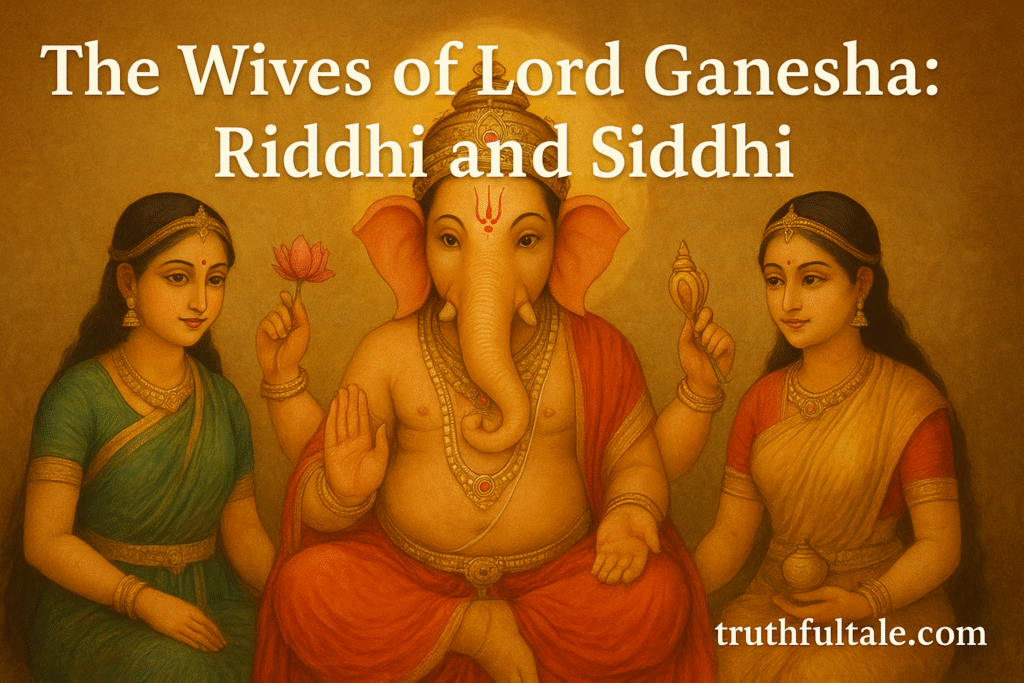The Wives of Lord Ganesha: Riddhi and Siddhi

Lord Ganesha, the remover of obstacles and the harbinger of wisdom, is one of the most beloved deities in Hinduism. While his childhood stories—like writing the Mahabharata, or the tale of how he got his elephant head—are well-known, not many people know about his marital life. According to ancient scriptures and traditions, Ganesha is believed to have two wives: Riddhi (prosperity) and Siddhi (spiritual power). Together, they complete the divine persona of Ganesha and add a profound meaning to his symbolism.
Who are Riddhi and Siddhi?
- Riddhi represents prosperity, wealth, and material success.
- Siddhi signifies spiritual power, wisdom, and inner growth.
By marrying both, Ganesha embodies a perfect balance of worldly happiness and spiritual progress. It highlights the belief that true success in life comes when material well-being is guided by wisdom.
The Reason Lord Ganesha Has Two Wives

The concept of Ganesha having two wives is deeply symbolic.
- On one hand, he blesses devotees with Riddhi (prosperity) to ensure a life of abundance.
- On the other, he grants Siddhi (spiritual power) so that wealth does not blind us, and we continue walking the path of righteousness.
Thus, his marital life represents a union of material and spiritual prosperity, teaching that both should coexist harmoniously in human life.
How Did Lord Ganesha Get Married?
There are many myths about how Ganesha got married. Two of the most popular stories are:
Brahma’s Intervention – Creation of Riddhi and Siddhi
Ganesha, being devoted to his parents, once declared that he would remain a brahmachari (celibate). The other gods worried, because someone as powerful as him should not remain unmarried.
They turned to Lord Brahma for help. To resolve the situation, Brahma created two divine maidens from his powers: Riddhi (prosperity) and Siddhi (spiritual success). He offered them to Ganesha, saying that they would balance his greatness.
Ganesha accepted them as his consorts, and from their union were born two sons:
- Shubh (auspiciousness)
- Labh (profit or gain)
This story explains why the phrase “Shubh-Labh” is inscribed at entrances and used during festivals, as it represents the blessings of Lord Ganesha’s divine family.
The Marriage Contest with Kartikeya
Another beloved folk story involves Ganesha and his brother Kartikeya. Once, they argued about who should be married first.
Shiva and Parvati decided to settle the matter with a test:
- Whoever circled the entire world fastest would be married first.
- Kartikeya immediately set off on his peacock to travel across the earth.
- But Ganesha, instead of rushing, circled his parents, Shiva and Parvati, declaring:
“For me, my parents are my entire world.”
Pleased with his wisdom, Shiva and Parvati declared him the winner. Soon after, Ganesha was married to Riddhi and Siddhi, two divine maidens who represented prosperity and wisdom.
Ganesha’s Marital Status Across India
Interestingly, Ganesha’s marital status varies across regions of India:
- In North India: Ganesha is almost always shown with his two wives, Riddhi and Siddhi, and his sons Shubh and Labh.
- In South India: He is often worshipped as a brahmachari (celibate), especially in Tamil Nadu and Karnataka. Some local legends suggest that no goddess was willing to marry him because of his elephant head, while others say he chose celibacy by devotion.
- In Maharashtra: Both traditions coexist. During Ganesh Chaturthi, Ganesha is celebrated as the beloved son of Parvati, but in folk songs and temple carvings, he also appears with his wives.
This diversity reflects the richness of Hindu traditions and how they adapt across regions.
Scriptural and Historical References
- The concept of Ganesha’s consorts is mentioned in the Mudgala Purana and the Ganesha Purana, where Riddhi and Siddhi are described as personifications of his powers.
- In certain Tantric texts, they are seen not as wives, but as shaktis (energies) of Lord Ganesha.
- Over time, devotional and Bhakti traditions began to depict them as his wives, giving rise to the family image of Ganesha with Riddhi, Siddhi, and their sons.
Symbolic Meaning of Ganesha’s Marriage
Ganesha’s union with Riddhi and Siddhi is not just a mythological tale, but a spiritual lesson:
- Without Riddhi (prosperity), life becomes difficult.
- Without Siddhi (spiritual wisdom), prosperity can lead to pride and downfall.
Together, they ensure balanced success—a timeless teaching that remains relevant in modern life.
Spiritual Insight
The stories of Lord Ganesha’s marriage to Riddhi and Siddhi reveal much more than mythology. They remind us that a fulfilling life requires both material abundance and spiritual wisdom. Whether worshipped as a bachelor in the South or as a husband with consorts in the North, Ganesha continues to guide devotees towards balance, happiness, and enlightenment.
So, next time you chant “Ganpati Bappa Morya”, remember that he not only removes obstacles but also blesses us with the twin gifts of Riddhi (prosperity) and Siddhi (spiritual success).
✨ Stay connected with Truthfultale.com for more stories of faith, culture, and spirituality.
